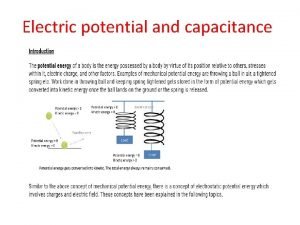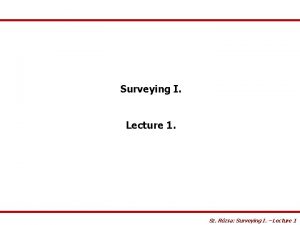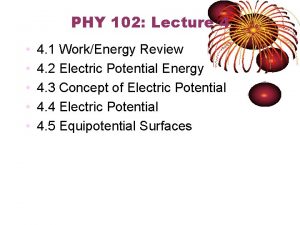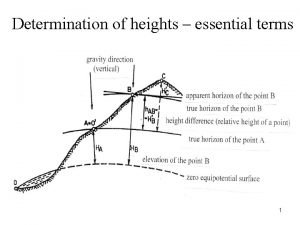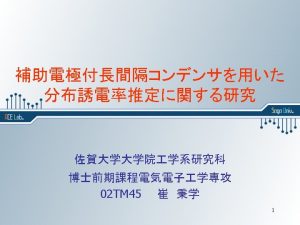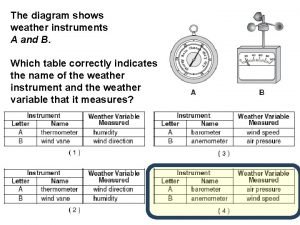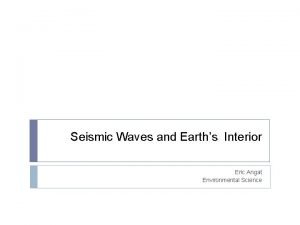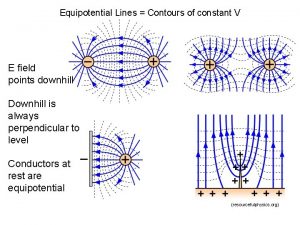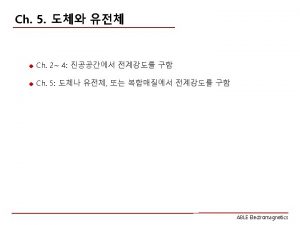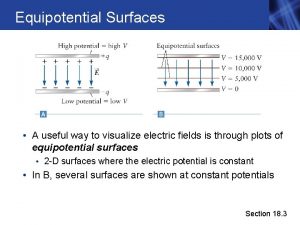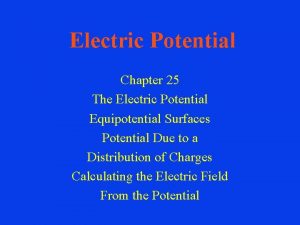An equipotential surface is a surface on which




















- Slides: 20

An equipotential surface is a surface on which the electric potential is the same everywhere. Since the potential at a distance r from an isolated point charge is V = kq/r, the potential is the same wherever r is the same.

The net electric force does no work as a charge moves on an equipotential surface. The net electric force does do work as a charge moves between equipotential surfaces.

The electric field created by any group of charges (or a single charge) is everywhere perpendicular to the associated equipotential surfaces and points in the direction of decreasing potential.

The surface of any conductor is an equipotential surface when at equilibrium under electrostatic conditions.

Actually, since the electric field is zero everywhere inside a conductor whose charges are in equilibrium, the entire conductor can be regarded as an equipotential volume.

When a charge is moved between the plates of a parallel plate capacitor, the force applied is the product of the charge and the electric field F = q 0 E. The work done is W = F∆s = q 0 E∆s.

From previous equations: ∆V = -W/q 0 = -q 0 E∆s/q 0 or ∆V = -E∆s or E = -∆V/∆s (The magnitude of E = V/d) The quantity ∆V/∆s is called the potential gradient.

Ex. 9 - The plates of a capacitor are separated by a distance of 0. 032 m, and the potential difference between them is ∆V = VB - VA = -64 V. Two equipotential surfaces between the plates have a potential difference of -3. 0 V. Find the spacing between the two equipotential surfaces.

A capacitor is composed of any two conductors of any shape placed near each other without touching. The region between the conductors is often filled with a material called a dielectric. A capacitor stores electric charge.

The proportion of charge to voltage in a capacitor is expressed with a proportionality constant called the capacitance C of the capacitor. q = CV The unit of capacitance is the coulomb/volt = farad (F).

One farad, one coulomb/volt is a huge capacitance. Usually smaller amounts are used in circuits -6 (microfarad, 1µF =10 F) -12 (picofarad, p. F = 10 F).

Capacitance describes the ability of a capacity to store charge. RAM chips contain millions of capacitors. A charged capacitor is a “ 1”, an uncharged capacitor is a “ 0” in the binary system.

A dielectric causes the electric field between the plates to decrease. This reduction is described by the dielectric constant κ, the ratio of the electric field strength E 0 without the dielectric to the strength E inside the dielectric: κ = E 0/E. (unitless)

E = E 0/k = V/d Remember E 0 = q/(ε 0 A), (CH 18) so, q/(κε 0 A) = V/d Solving for q, gives: q = (κε 0 A/d)V, but q = VC, so: capacitance C = κε 0 A/d.

If C 0 is the capacitance of an empty capacitor, the capacitance of a capacitor with a dielectric is C = κC 0. Since all dielectrics (except a vacuum) have a κ that is greater than 1; the purpose of a dielectric is to raise the capacitance.

Ex. 10 - The capacitance of an empty capacitor is 1. 2 µF. The capacitor is connected to a 12 -V battery and charged up. With the capacitor connected to the battery, a slab of dielectric material is inserted between the plates. As a result, 2. 6 x 10 -5 C of additional charge flows from one plate, through the battery, and on to the other plate. What is the dielectric constant κ of the material?

A capacitor is a device for storing charge, but also energy. The total work done by a battery in charging a capacitor is 1/2 q. V. This is stored in the capacitor as electrical potential energy, EPE = 1/2 q. V. q = CV, 2 so energy = 1/2 CVV = 1/2 CV.

But V = Ed, and C = κε 0 A/d, so: 2 Energy = 1/2 (κε 0 A/d)(Ed). A x d = the volume between the plates, so: Energy density = 2 energy/volume = 1/2 κε 0 E. This is valid for any electric field strength, not just between the plates of a capacitor.

Capacitors are used to build up a large charge with a high potential which can then be released when needed. Capacitors such as this are used in electronic flashes in cameras, tazers and in defibrillators.

 Potential and capacitance
Potential and capacitance Shape of equipotential surface in uniform electric field
Shape of equipotential surface in uniform electric field Equipotential surface
Equipotential surface What do you understand by equipotential surface
What do you understand by equipotential surface Equipotential surface
Equipotential surface Mgh gpe
Mgh gpe Equipotential lines
Equipotential lines Ellispsoid
Ellispsoid Equipotential grounding
Equipotential grounding Define electric potential and potential difference.
Define electric potential and potential difference. Gravitational potential isolines
Gravitational potential isolines Seepage loss formula
Seepage loss formula Lateral surface area of the prism
Lateral surface area of the prism High surface tension vs low surface tension
High surface tension vs low surface tension Curved surface area of cone
Curved surface area of cone Diagram of weather instruments
Diagram of weather instruments Look at each picture
Look at each picture Which is the best surface for reflecting heat radiation
Which is the best surface for reflecting heat radiation Which type of wave can penetrate the outer and inner core
Which type of wave can penetrate the outer and inner core Venus’s surface shows all of the following except
Venus’s surface shows all of the following except How does heat energy flow
How does heat energy flow
